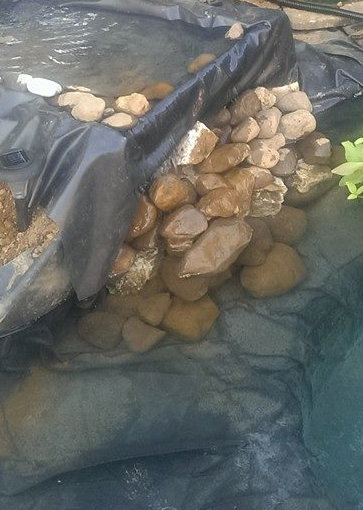Pond liners serve two important functions; they hold the water in a pond and they keep the water clean and free from sediments in order to develop the best man-made aquatic habitat possible.
The longevity of a pond liner is very important to avoid repair work and reinstating a pond. Rubber or plastic pond liners installed unprotected would have to stand up to sharp animal claws and soil processes. However, a protected flexible pond liner could be expected to more than double it’s life expectancy. If you’re thinking about adding a pond to your garden or looking to refurbish an existing one, you’ll be familiar with the modern materials used to create a waterproof lining. These can range from rigid preformed plastic or GRP (fibreglass) shells to flexible linings made from PVC (plastic), butyl or Epalyn (EPDM) rubber. When using a flexible pond liner, you should first provide some protection for the liner against sharp stones and roots before laying it in the pond recess. The most commonly used protective underlay liner these days is a geotextile fabric made from non-woven polypropylene or polyester which has been needle punched to give it a felt-like texture. The material is extremely tough and will give a high degree of protection against sharp objects. Importantly, it will also last as long as the liner itself, unlike some of the home-made alternatives such as layers of newspaper and old carpets.
What is less well known is that the same geotextile material can be used as a protective pond liner overlay – and there are several reasons why this would be the case. The main area where an underlay is used as a protective overlay is on top of the lining around the edge of a pond, where the flexible lining rises out of the water and lies on top of the surrounding soil or collar. Here an additional layer of geotextile fabric is placed on top of the liner before the stones or slabs, that will form the border of the pond, are put in place. Similarly, if your pond features an underwater shelf or platform for shallow water plants, those areas too should use a protective overlay. The presence of an overlay can also provide some protection against the sharp claws of pet dogs or cats – and even the stab of a heron’s beak. 
Another area that can benefit from a protective pond liner overlay is underneath objects such as stone features or plant containers that you add to your pond. In some cases, particularly when you are trying to create a natural habitat for pond life by adding soil or gravel to your pond, or just trying to create an attractive pebbled pond floor, the whole floor of your pond can be given a protective overlay with geotextile material. As well as protecting your liner, the textured surface of the fabric will discourage pebbles and other features sliding if the floor of your pond is not level. You might find our previous Blog article ‘How to get your pond liner size just right’ helpful in calculating the right size for your pond liner and underlay to avoid over or under ordering.
The attached photograph shows a newly constructed pond. Adding a sheet of protective underlay above the pond liner where the boulders secure the pond liner in place beneath the end of the stream where water flows into the pond, will offer the pond liner added protection.






You can find absolutely a great deal of details like that to take into consideration. That’s a terrific point to bring up. I offer the thoughts above as general inspiration but clearly you will find questions like the one you bring up where probably the most vital factor is going to be working in honest superior faith. I don?t know if most effective practices have emerged around points like that, but I am positive that your job is clearly identified as a fair game. Each boys and girls really feel the impact of just a moment’s pleasure, for the rest of their lives.
You made a number of nice points there. I did a search on the subject matter and found nearly all persons will consent with your blog.
Greetings from Carolina! I’m bored at work so I decided to check out your blog on my iphone during lunch break. I enjoy the info you present here and can’t wait to take a look when I get home. I’m shocked at how quick your blog loaded on my mobile .. I’m not even using WIFI, just 3G .. Anyhow, good site!